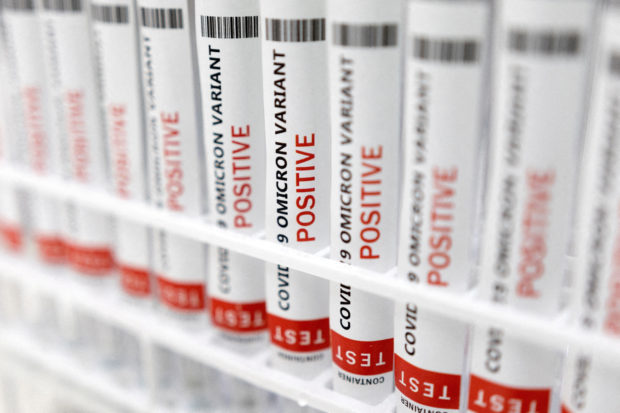
FILE PHOTO: Test tubes labeled “COVID-19 Omicron variant test positive” are seen in this illustration picture taken January 15, 2022. REUTERS/Dado Ruvic/Illustration/File Photo
MANILA, Philippines — The national weekly positivity rate for COVID-19 infection jumped to 14.8 percent, but remained at low risk classification, said the Department of Health (DOH) Thursday, while Metro Manila was upgraded to moderate risk.
“Tumaas din ang positivity rates natin from 12.5 percent to 14.8 percent this week katulad po ng rate natin noong February,” said DOH assistant spokesperson Usec. Beverly Ho in a media briefing.
(Our positivity rates also increased from 12.5 percent to 14.8 percent this week, which is similar to our rate in February.)
This is almost triple with the World Health Organization’s ideal threshold for positivity rate.
However, Ho explained that the country remains at a low-risk classification despite the increase in positivity rate.
“Nationally nanatili pa rin tayong low risk classification na meron pong daily average attack rate na 2.33 cases per 100,000 population,” said Ho.
(Nationally, we remain at a low-risk classification with a daily average attack rate of 2.33 cases per 100,000 population.)
NCR at moderate risk
Meanwhile, Metro Manila was escalated into moderate risk classification as it currently has a daily moving average of 1,100 cases per day and an ADAR (average daily attack rate) of 7.25 cases per 100,000 population, said Ho in a separate response to reporters.
All other regions, on the other hand, remained at low-risk classification despite a reported increase in the past two weeks.
“‘Yun ang trend talaga natin pero lahat ng rehiyon nanatiling low risk, pero may seven tayong regions na nakapagtala ng ADAR na ranging from 1.45 to 3.96 cases per 100,000 population,” said Ho.
(That’s really our trend, but all regions remain a low risk, but we have seven regions that recorded ADAR ranging from 1.45 to 3.96 cases per 100,000 population.)
Ho added that the continuous increase in cases also did not translate into an increase in COVID-19 admissions as the number of severe and critical cases continues to be below 1,000, only at 734.
“Nanatiling asymptomatic po ang nasa 16.49 percent at mild na nasa 40.97 percent ang karamihan ng mga naospital na kababayan,” she said.
(16.49 percent remained asymptomatic and 40.97 percent of the hospitalized compatriots were mild.)
But Ho noted an increase of about 12 percent or 757 in total COVID-19 hospital admissions, with the ICU utilization rate currently at 21 percent.
Despite this, healthcare utilization rate both nationally and in Metro Manila remain at low risk, said Ho.
Vaccination Status
Meanwhile, 71.6 million Filipinos have now been vaccinated against COVID-19, including 9.7 million adolescents, 4 million children, and 6.8 million senior citizens.
More than 16 million individuals have also been inoculated with their first booster shot, while 1.2 million have received their second booster shot.
The DOH recently launched the “PinasLakas” program, which aimed to administer booster jabs to at least 23 million people or 50 percent of the eligible population within the first 100 days of President Ferdinand Marcos Jr.’s administration.